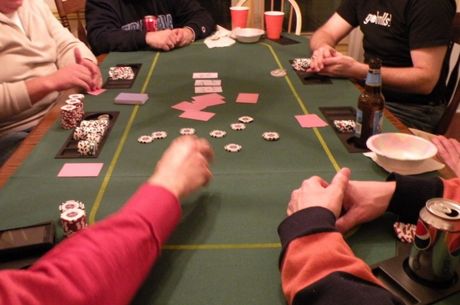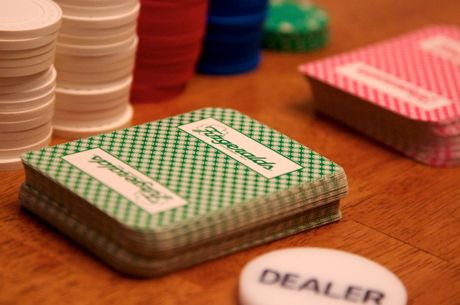7 Ways to Raise the Stakes in Your Home Game

You play in a regular home game. It’s a limit dealer’s choice game. You’re crushing the game, as the other guys think poker is just a fun game of luck — and play that way. There’s only one problem. The stakes are really low.
Though they are all fairly successful in their work, and have increased their income tenfold since you all began playing together 15 years earlier, the stakes are the same as they were when you started to play. You know they can afford a bigger game, but you don’t want to make it look like you want to take advantage of the fact that you’re a better player (though that is exactly what you want to do). But with stakes this low, the game is hardly worth your time anymore. What can you do?
Here are a few techniques for raising the stakes of your great home poker game without making it look like you’re raising the stakes. Patience is key for all of these suggestions, as is the idea of raising the stakes gradually (as opposed to introducing sudden changes in the game).
1. Add Betting Rounds
Introduce a couple of new games. They can be exactly like the other dealer’s choice games, except they will have an extra round or two of betting. Here are a couple of examples.
You normally play seven-card stud high-lo. It’s a great poker game for this fairly casual poker crowd because there are usually two winners — the highest hand and the lowest hand — satisfying two players a hand, rather than just one.
The way they all play the game, the “cards speak” after the betting on the last card, and the high splits with the low. You can offer a variation where the players declare whether or not they are going low or going high, using chips or coins in the hand that are revealed after the betting on the last card. That adds a layer of skill to the game — namely, the ability to figure out which way your opponents are likely to declare while disguising your true intentions until you declare. Fair enough.
But you are not introducing this wrinkle just because of this extra level of skill. Rather, you are looking for an opportunity to make extra money with an additional betting round.
After the crowd becomes familiar with the declare round, you can add another twist — a betting round after the declare. Once players declare their intention, if any two are going in the same direction you can have another round of betting — a sixth round in what otherwise would be a game with only five betting rounds. This builds the size of pot and can lead to other gradual modifications that raise the stakes, as you will see.
2. Introduce Replacement Cards
Another way to introduce an extra betting round into a familiar game is to add the option of replacing one of your cards at the end of the hand.
Instead of a regular Omaha high-low game, for example, add the twist of a replacement round at the end, where players can replace one of their cards for some small extra charge, followed by a betting round. This adds a betting round and builds the pot with cost of the replacement card. You can take this a step further by adding two or more replacements, making the second and all subsequent replacements double the cost of the last.
For example, in a $1/$2 fixed-limit game of Omaha high-low, make the first replacement $5, the second one $10, the third one $20, etc. (By this point you can forgo adding another betting round after each of these replacements, as the extra money from the replacements will sufficiently engorge the size of the pot.) You’ll get suckers paying $80 for their fifth replacement, and they’ll still be drawing dead. And they’ll have fun doing it.
3. Increase the Bet on the Final Round
But that’s only one way the stakes will be increasing. After a while, you may suggest that since there’s an extra betting round, and since the pot is already so big from the extra rounds (and the money from the replacements), it seems only natural to allow for that final bet, after the declare, to be larger that the other rounds.
For example, if you had been playing a $1/$2 limit game, you might suggest that this sixth round be increased to $5 “just to keep things interesting.” There’s a logic to the increase on the final round that may appeal even to the traditionalists who don’t really want to increase the overall size of the game.
Similarly, once you have that final round of betting pegged at $5, it might make sense for your poker group to move to a $5 limit for every round, or, perhaps, for the final two rounds. You wouldn’t suggest making your $1/$2 game a $5 limit game right away, but over time, in small steps, it’s often a lot easier.
Those are some ideas for increasing the stakes in fixed-limit games. Let’s move over to some for upping the stakes in no-limit games — some of which are obvious, and some less so.
4. Raise the Buy-Ins
One way to increase the stakes in a no-limit game is to raise the buy-in. If you play $0.25/$0.50 blinds with a $20 minimum and a $50 maximum buy-in, you might go to a $100 maximum buy-in while keeping the blinds the same. No one has to increase what they buy in for, so even the more tight-fisted among you won’t have much reason to squawk.
Another fairly obvious way to increase the size of the game is to allow players to buy in for the size of the currently largest stack. Again, it won’t really affect the game of a player who doesn’t want to buy in for more than he has traditionally bought in for, but it will surely put more money in the game, increasing the amount you may win.
Over time, most players won’t want to be the shortest stack on the table, and they may well increase how much they buy in for, too. In time, gradually, what you’ve done is increased the amount everyone puts on the table, making the game play bigger.
Those might be obvious changes. A less obvious way to up the stakes in no-limit games is to just start changing how people buy in to the game.
5. Change from Cash to Chips
If you play with cash, move over to chips. It will greatly affect the stakes of the game, as players will become looser with chips than they were with cash. By using chips you may also stop the use of coins. Coins help to slow down the growth of a game, by inflating by contrast the value of paper money and chips.
When you go to chips, the differences between $1 and $5 becomes only a difference in color, not in kind, making it psychologically easier for people to part with their money. They won’t tend to notice the change as a change in stakes, since their initial buy-in and the blinds will be the same, but a change will definitely occur. It will be easier for players to make larger bets — as using chips will psychologically tend to separate the game from the real world of money that they associate with coins and bills.
6. Color Up Your Chips
Similarly, if you currently use chips, you can start gradually introducing larger denomination chips to the game. It doesn’t have to be all at once. But start to use the higher denomination chips as people buy in.
If people typically buy in for $50, instead of giving them 50 $1 chips, give them 5 $5 chips and 25 $1 chips. If they buy in for $100, start them off with $10 in white $1 chips, $40 in $5 red chips, and $50 in two green $25 chips. It will increase the stakes by decreasing the difficulty of betting larger amounts. And it will increase the speed with which their bets take place, as it will require less stacking and counting of chips as bets are made.
I’ve noticed this phenomenon happen in $1/$2 games in many casino poker rooms. Those that have only $1 chips play much, much smaller than games where players typically get a stack of red chips when they buy in. The bigger the currency in circulation, the bigger the game — even if the official stakes don’t go up at all.
7. Add a Third Blind
Once you are playing with larger denomination chips in the game, it becomes easier to suggest moving the stakes up to a higher level. Introducing a third blind is one easy way of starting to inch the stakes upward.
With $5 chips in the game, it’s easier to suggest moving from $1/$2 to $1/$2/$5. Similarly, if you’re already at $1/$2/$5, it’s easier to suggest moving to $2/$5 than to go right away from $1/$2 to $2/$5.
Final Thoughts
For those wishing to up the stakes in their home game, there’s always the most direct method. Simply explain that poker is most fun when the stakes mean something, and suggest increasing the stakes to make the game more meaningful to everyone. But before alerting your fellow players to your intention with the clear and direct approach, I suggest you might try these less direct methods that I’ve outlined above.
One final note of caution, however, before you rush off to increase gradually the size of your game. The above scenarios are built on the premise that all of the players in the game could really and easily afford a bigger game. But initial appearances notwithstanding, that may not always be the case.
As you increase the stakes, you may find out some of the regulars start losing more than they really feel comfortable losing. Accordingly, they may decide that the game you have cleverly created is really not for them and they may stop coming, putting in peril what had been a wonderful regular home game.
So just be careful that you and your great home game don’t unwittingly become a victim of your own success.
Photo: “Poker Chips,” Faris. Creative Commons Attribution 2.0 Generic.
Ashley Adams has been playing poker for 50 years and writing about it since 2000. He is the author of hundreds of articles and two books, Winning 7-Card Stud (Kensington 2003) and Winning No-Limit Hold’em (Lighthouse 2012). He is also the host of poker radio show House of Cards. See www.houseofcardsradio.com for broadcast times, stations, and podcasts.
Want to stay atop all the latest in the poker world? If so, make sure to get PokerNews updates on your social media outlets. Follow us on Twitter and find us on both Facebook and Google+!










